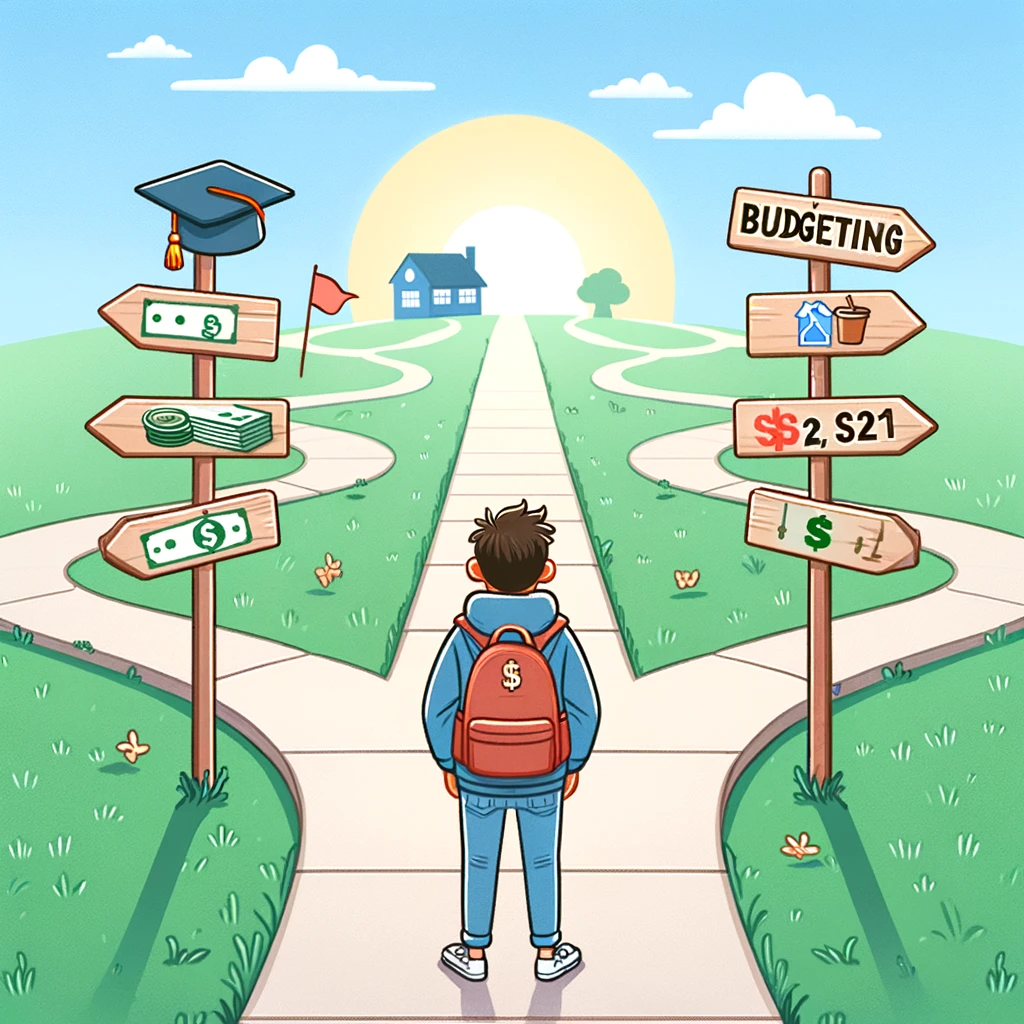Introduction
In today’s financial climate, the issue of student loan debt stands as a significant challenge, affecting millions of graduates who are seeking pathways to financial stability and independence. The urgency of shedding the weight of student loans is more than just a financial mandate; it’s a critical step towards achieving life’s major milestones, such as purchasing a home or saving for retirement. Recognizing the pivotal importance of this issue, this article delves into a variety of strategic approaches aimed at accelerating the repayment process. Through an exploration of key strategies, from understanding loan terms to implementing aggressive repayment tactics, it aims to equip readers with the knowledge and tools necessary to navigate their way out of debt swiftly and efficiently. This guide is crafted to serve as your beacon through the complex terrain of student loans, illuminating the path to financial freedom with actionable advice and proven methods.
Understanding Your Student Loans
Embarking on the journey to pay off student loans swiftly necessitates a foundational understanding of the loans themselves. Grasping the nuances of one’s loan terms and conditions, alongside recognizing the distinctions between federal and private loans, forms the cornerstone of any effective repayment strategy.
Deciphering Your Loan Terms and Conditions
At the heart of student loan management lies a thorough comprehension of the loan’s interest rates and terms. Interest rates, either fixed or variable, play a pivotal role in determining the total amount repaid over the life of the loan. A fixed interest rate remains constant throughout the loan term, offering predictability in monthly payments. Conversely, a variable rate may fluctuate in response to changes in market interest rates, impacting monthly payment amounts and the total interest paid.
Understanding the loan term, or the period over which the loan must be repaid, is equally critical. Longer loan terms generally result in lower monthly payments but lead to higher total interest costs over time. Conversely, shorter terms accelerate the repayment process but demand higher monthly payments.
The fine print of loans often includes additional terms and conditions that can significantly affect repayment strategies. These can encompass penalties for early repayment, options for loan deferment or forbearance, and provisions for loan forgiveness or discharge. Familiarity with these details empowers borrowers to navigate their repayment journey with confidence, tailoring their approach to align with their financial goals and capabilities.
The Impact of Federal vs. Private Loans
Distinguishing between federal and private loans is essential, as each comes with its own set of rules, benefits, and flexibility in terms of repayment. Federal loans, backed by the government, typically offer lower interest rates and more flexible repayment options compared to private loans. These options include income-driven repayment plans, which adjust monthly payments based on the borrower’s income and family size, and loan forgiveness programs for those in certain public service careers.
Private loans, offered by banks, credit unions, and other private entities, lack the safety nets inherent to federal loans. Interest rates can be higher and more variable, and flexibility in repayment terms often pales in comparison to that of federal loans. However, for some borrowers, private loans might fill gaps not covered by federal aid, serving as a necessary component of financing their education.
In summary, a deep dive into the specifics of student loans, discerning the intricacies of interest rates, terms, and the stark contrasts between federal and private loans, lays the groundwork for informed, strategic decisions in the quest to extinguish student loan debt expediently. This knowledge acts as a powerful tool, enabling borrowers to devise a repayment plan that is both ambitious and achievable, tailored to their unique financial landscape.
Creating a Repayment Game Plan
For those navigating the path to financial freedom, crafting a meticulous repayment game plan stands as a critical milestone. This plan hinges not only on a well-structured budget but also on the strategic application of proven debt repayment methodologies. Embracing these elements ensures a more directed and effective approach to shedding student loan debt.
Budgeting for Success
The cornerstone of any successful loan repayment strategy is a robust and flexible budget. This financial blueprint should prioritize student loan payments, ensuring they’re treated not as afterthoughts but as central pillars of monthly expenditure. Adjusting your budget to accommodate these payments often requires a thorough assessment of income and expenses, identifying areas of potential savings or reallocation.
Tips for adjusting your budget:
- Evaluate and reduce discretionary spending: Analyze monthly spending to identify non-essential expenses that can be minimized or eliminated.
- Utilize budgeting tools and apps: Many digital solutions offer insightful breakdowns of spending habits, helping to identify opportunities for adjustments. Apps like Mint, YNAB (You Need A Budget), and PocketGuard can automate much of this process, providing real-time insights and suggestions for better financial management.
- Set clear financial goals: Having specific, measurable goals related to debt repayment can motivate and guide budgetary adjustments.
The Snowball vs. Avalanche Methods
When tackling the actual repayment of loans, two popular strategies emerge: the snowball and avalanche methods. Both approaches offer structured paths to debt freedom but differ in their tactics and focuses.
Snowball Method:
- This strategy involves paying off debts from smallest to largest, regardless of interest rate. The psychological wins of clearing smaller debts quickly can provide motivation and momentum.
- Pros: Immediate sense of progress; increased motivation.
- Cons: Potentially higher interest costs over time.
Avalanche Method:
- Contrary to the snowball approach, the avalanche method prioritizes debts with the highest interest rates first, moving to those with lower rates once the higher-interest debts are paid off. This strategy can minimize the amount paid in interest over time.
- Pros: Lower total interest costs; faster reduction of overall debt burden.
- Cons: May take longer to feel progress if high-interest debts have large balances.
Deciding between the snowball and avalanche methods depends on personal preference, financial circumstances, and psychological inclinations. Some may find the quick wins of the snowball method more motivating, while others may prefer the long-term efficiency of the avalanche approach. Incorporating either strategy into your repayment game plan can significantly enhance your ability to manage and eliminate student loan debt effectively.
Strategies to Pay Off Your Loans Faster
To navigate the path toward debt freedom, adopting strategies that transcend standard repayment plans can significantly shorten the journey. Here, we explore actionable tactics designed to amplify the impact of your repayment efforts, ensuring every dollar works harder toward eliminating your student loan debt.
Making More Than the Minimum Payment
The practice of contributing more than the minimum required payment on your student loans can dramatically alter the course of your repayment timeline. By directing additional funds towards the principal balance, rather than just covering interest, borrowers can significantly reduce the amount of interest accrued over the life of the loan.
Key Insights:
- Reducing Principal Faster: Each additional payment made above the minimum directly reduces the loan’s principal, thereby decreasing the total interest that can accumulate over time.
- Strategic Allocation: When making extra payments, ensure they are applied to the principal of the loan with the highest interest rate, maximizing the efficiency of each dollar.
Exploring Refinancing and Consolidation
Refinancing and consolidation offer powerful avenues for borrowers to restructure their student loans under potentially more favorable terms. Refinancing typically involves obtaining a new loan to pay off existing loans, often securing a lower interest rate in the process. Consolidation, particularly for federal student loans, combines multiple loans into a single loan with a weighted average interest rate.
Considerations:
- Interest Rates: A lower interest rate through refinancing can reduce both monthly payments and the total cost over the life of the loan.
- Loan Terms: Adjusting the repayment term can offer flexibility; shorter terms mean higher payments but faster debt clearance, while longer terms reduce monthly payments but increase total interest paid.
- Eligibility for Forgiveness: Refinancing federal loans with a private lender eliminates eligibility for federal forgiveness programs and income-driven repayment plans, a crucial consideration for many borrowers.
Leveraging Forgiveness and Assistance Programs
For borrowers with federal student loans, various forgiveness and assistance programs offer pathways to reduce or eliminate debt based on employment, income, or other factors. Programs like Public Service Loan Forgiveness (PSLF) and Teacher Loan Forgiveness are designed to reward individuals for service in certain professions.
Program Insights:
- Understanding Eligibility: Carefully review the qualifications for each program, as they can be quite specific and may require a certain number of payments or years of service.
- Application Process: Engage with your loan servicer early and often to ensure you’re on track to meet program requirements and to navigate the application process effectively.
Using Windfalls Wisely
Unexpected financial gains, such as bonuses, tax refunds, or inheritances, present unique opportunities to make significant inroads into student loan balances. Instead of allocating these windfalls to discretionary spending, applying them to your student loan debt can have a lasting impact.
Strategies for Maximization:
- Immediate Application: Promptly applying windfall funds to student loan balances can prevent the temptation to spend elsewhere, ensuring these funds make a direct impact on your debt.
- Target High-Interest Loans: Similar to making extra payments, directing windfall amounts towards loans with the highest interest rates maximizes the debt reduction effect.
By integrating these strategies into your repayment plan, the goal of becoming student loan debt-free transitions from a distant dream to an achievable reality. Each method provides a different lever to pull in your quest for financial freedom, offering both immediate and long-term benefits to your financial health
Side Hustles to Boost Your Repayment Funds
In today’s gig economy, identifying a side hustle can be a strategic move to expedite the repayment of student loans. These additional streams of income can significantly increase your monthly payments, reducing both the loan term and the total interest paid.
Potential Side Jobs and Gigs
- Freelance Work: Utilize skills in writing, graphic design, web development, or social media management to secure freelance gigs on platforms like Upwork, Freelancer, or Fiverr.
- Rideshare Driving: Platforms like Uber and Lyft offer flexible opportunities for earning extra income during your spare time.
- Online Tutoring: If you excel in a particular subject, online tutoring can be a lucrative option, with platforms like Tutor.com or VIPKid.
- Selling Handmade Goods: Sites like Etsy provide a marketplace for selling handmade crafts, artwork, and vintage items.
Balancing Tips:
- Set Clear Boundaries: Allocate specific hours to your side hustle to prevent it from encroaching on your primary job or personal life.
- Stay Organized: Use tools and apps to manage your tasks and schedules efficiently, ensuring you remain productive across all responsibilities.
- Prioritize Self-Care: Avoid burnout by ensuring you have enough downtime. Remember, the goal is to use the side hustle to improve your financial situation, not to impair your health or well-being.
Staying Motivated and Avoiding Burnout
Tracking Your Progress
Monitoring your loan repayment journey is essential for maintaining motivation. Visualizing the reduction in your debt can provide a psychological boost, reinforcing the impact of your efforts.
Tools and Methods:
- Debt Repayment Apps: Apps like Unbury.Me or Debt Payoff Planner provide visual graphs and timelines of your debt repayment, including how extra payments shorten the loan term.
- Spreadsheets: Customizable and detailed, spreadsheets allow you to track your payments, interest rates, and remaining balance over time, offering a clear view of your progress.
Celebrating Milestones
Recognizing and celebrating key milestones in your loan repayment journey can significantly bolster your motivation and prevent burnout. These milestones can be as simple as paying off a specific loan, reducing your total debt to a certain figure, or reaching the halfway point in your repayment timeline.
Celebration Ideas:
- Treat Yourself: Allow for small, budget-friendly rewards that don’t derail your financial goals, such as a nice meal out or a movie night.
- Share Your Success: Inform friends or family about your achievements to receive support and encouragement, reinforcing your commitment to your financial goals.
- Reflect on Your Journey: Take time to appreciate the effort and sacrifices made, acknowledging the hard work and discipline involved in reaching each milestone.
Adopting these strategies enhances the loan repayment process, transforming it from a daunting task into a series of achievable, rewarding steps towards financial freedom. The combination of additional income streams, progress tracking, and milestone celebrations provides a comprehensive approach to managing student loan debt effectively, ensuring both financial advancement and personal well-being.
Conclusion
In wrapping up our exploration of strategies to expedite the repayment of student loans, we’ve traversed a variety of approaches—from adjusting your budget and making more than the minimum payments to considering refinancing and seeking out forgiveness programs. Each strategy offers a unique avenue to not only manage but significantly reduce your debt burden, providing a clearer path to financial freedom. Now, armed with these insights, the time is ripe to take the first steps in applying these strategies to your own student loans. The road to repaying student debt may seem daunting, but with a solid game plan, the goal of financial independence is well within reach. Let this guide serve as your starting point toward a debt-free life, encouraging you to tackle your student loans with renewed vigor and confidence.



